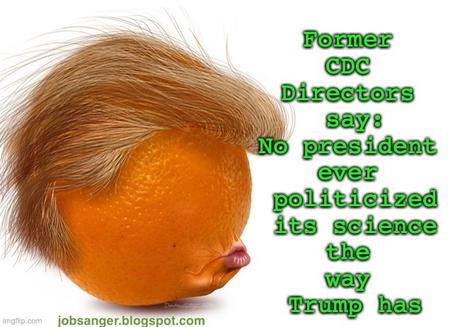
The Center for Disease Control (CDC) was created to protect the health of the citizens of this country. And it has been very effective in doing that -- until now. That's because all previous presidents have followed the guidance of the scientists in that agency. Sadly, Trump is different. If the CDC guidelines don't say what he wants, he demands the agency change. He is demanding the agency, which depends on good science, deny that science to please him.
The following op-ed in The Washington Post was written by four former CDC directors (Tom Frieden, Jeffrey Koplan, David Satcher, Richard Besser) who served under both Republican and Democratic presidents. They write:
As America begins the formidable task of getting our kids back to school and all of us back to work safely amid a pandemic that is only getting worse, public health experts face two opponents: covid-19, but also political leaders and others attempting to undermine the Centers for Disease Control and Prevention. As the debate last week around reopening schools more safely showed, these repeated efforts to subvert sound public health guidelines introduce chaos and uncertainty while unnecessarily putting lives at risk.
As of this date, the CDC guidelines, which were designed to protect children, teachers, school staffers and their families — no matter the state and no matter the politics — have not been altered. It is not unusual for CDC guidelines to be changed or amended during a clearance process that moves through multiple agencies and the White House. But it is extraordinary for guidelines to be undermined after their release. Through last week, and into Monday, the administration continued to cast public doubt on the agency’s recommendations and role in informing and guiding the nation’s pandemic response. On Sunday, Education Secretary Betsy DeVos characterized the CDC guidelines as an impediment to reopening schools quickly rather than what they are: the path to doing so safely. The only valid reason to change released guidelines is new information and new science — not politics.
One of the many contributions the CDC provides our country is sound public health guidance that states and communities can adapt to their local context — expertise even more essential during a pandemic, when uncertainty is the norm. The four of us led the CDC over a period of more than 15 years, spanning Republican and Democratic administrations alike. We cannot recall over our collective tenure a single time when political pressure led to a change in the interpretation of scientific evidence.
The CDC is home to thousands of experts who for decades have fought deadly pathogens such as HIV, Zika and Ebola. Despite the inevitable challenges of evolving science and the public’s expectation of certainty, these are the people best positioned to help our country emerge from this crisis as safely as possible. Unfortunately, their sound science is being challenged with partisan potshots, sowing confusion and mistrust at a time when the American people need leadership, expertise and clarity. These efforts have even fueled a backlash against public health officials across the country: Public servants have been harassed, threatened and forced to resignwhen we need them most. This is unconscionable and dangerous.
We’re seeing the terrible effect of undermining the CDC play out in our population. Willful disregard for public health guidelines is, unsurprisingly, leading to a sharp rise in infections and deaths. America now stands as a global outlier in the coronavirus pandemic. This tragic indictment of our efforts is even more egregious in light of the disproportionate impact we’ve witnessed on communities of color and lower-income essential workers. China, using the same mitigation tools available to us and with a far larger population, has had just a tiny fraction of the 3.1 million cases reported here. The United States now has more cases and deaths than any other country and the sixth-highest rate of any large country in the world — and we are gaining on the other five. The United States is home to a quarter of the world’s reported coronavirus infections and deaths, despite being home to only 4.4 percent of the global population.
Sadly, we are not even close to having the virus under control. Quite the opposite, in fact.
That’s what makes it hard to plan for schools. Any parent with a young child knows that classrooms, cafeterias and school buses are petri dishes for the common cold and the flu, even in normal times. And although children are at lower risk for serious illness and death from covid-19, the same is not true for the adults who work in schools, nor for the families children and school staffers go home to each evening. We must pay careful attention to safer school policies, including those the CDC released, to do everything we can to reopen our schools — and our economy — as safely as possible. This cannot happen equitably without additional federal and state resources to ensure that every school district — no matter the Zip code — can take the necessary measures to protect children, teachers and staffers. Black, Latino and Native American communities have suffered disproportionately during the first six months of the pandemic. We cannot let this same tragedy unfold this fall in our schools. The CDC’s guidance is a call for all of our nation to work together so as many schools as possible can reopen as safely as possible. This will mean wearing masks correctly, increasing distance — including by closing bars and restaurants in many places — and tracking and stopping the spread of the virus by supporting patients and protecting contacts.
Trying to fight this pandemic while subverting scientific expertise is like fighting blindfolded. How well and how quickly we adhere to the advice of public health experts at the CDC will determine whether, how soon and how safely our schools can reopen.
It is not too late to give the CDC its proper role in guiding this response. But the clock is ticking.

